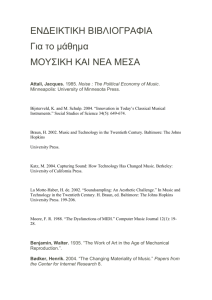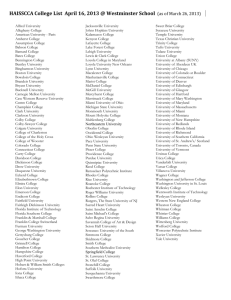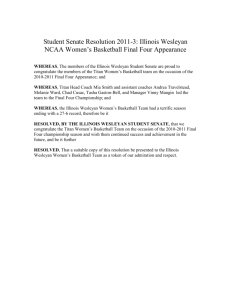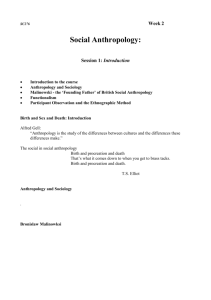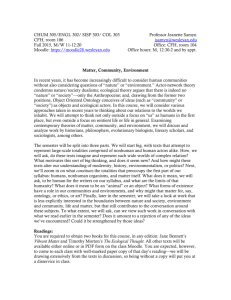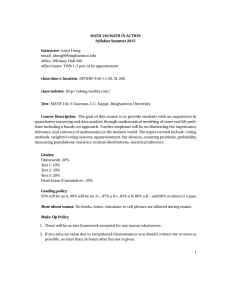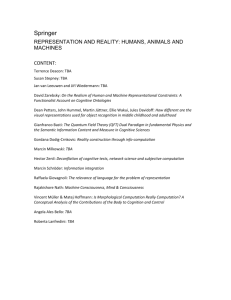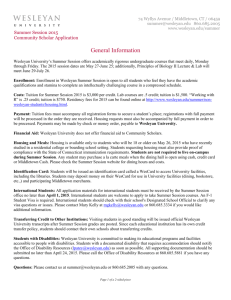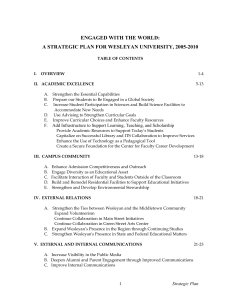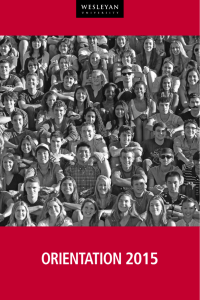Syllabus - WesFiles - Wesleyan University
advertisement
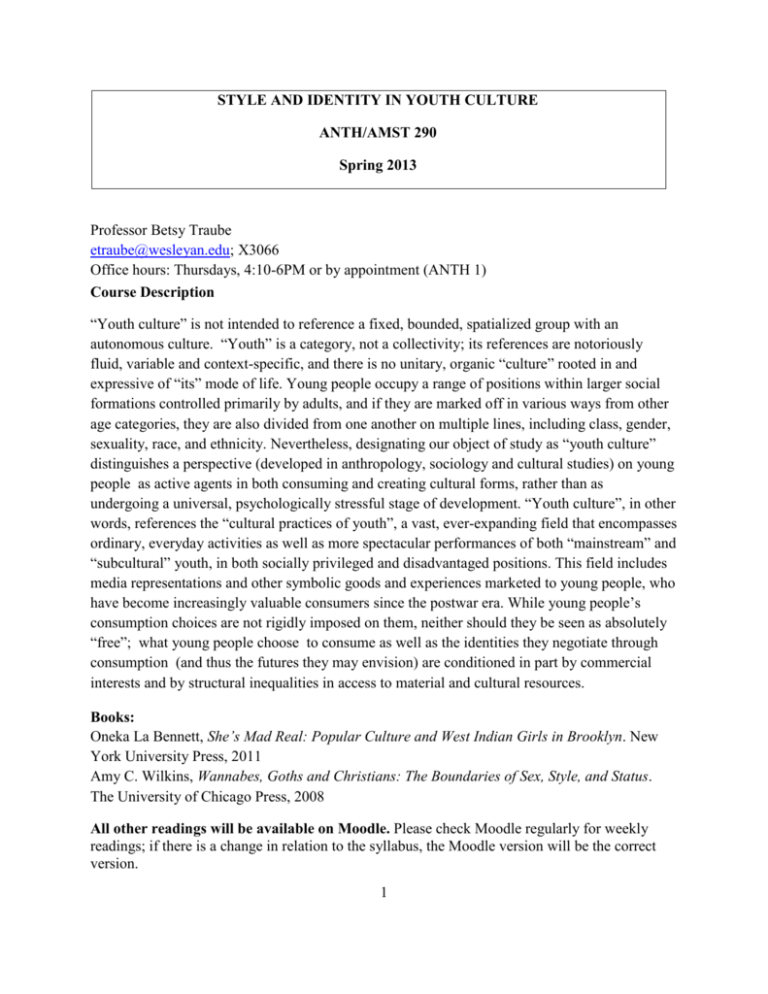
STYLE AND IDENTITY IN YOUTH CULTURE ANTH/AMST 290 Spring 2013 Professor Betsy Traube etraube@wesleyan.edu; X3066 Office hours: Thursdays, 4:10-6PM or by appointment (ANTH 1) Course Description “Youth culture” is not intended to reference a fixed, bounded, spatialized group with an autonomous culture. “Youth” is a category, not a collectivity; its references are notoriously fluid, variable and context-specific, and there is no unitary, organic “culture” rooted in and expressive of “its” mode of life. Young people occupy a range of positions within larger social formations controlled primarily by adults, and if they are marked off in various ways from other age categories, they are also divided from one another on multiple lines, including class, gender, sexuality, race, and ethnicity. Nevertheless, designating our object of study as “youth culture” distinguishes a perspective (developed in anthropology, sociology and cultural studies) on young people as active agents in both consuming and creating cultural forms, rather than as undergoing a universal, psychologically stressful stage of development. “Youth culture”, in other words, references the “cultural practices of youth”, a vast, ever-expanding field that encompasses ordinary, everyday activities as well as more spectacular performances of both “mainstream” and “subcultural” youth, in both socially privileged and disadvantaged positions. This field includes media representations and other symbolic goods and experiences marketed to young people, who have become increasingly valuable consumers since the postwar era. While young people’s consumption choices are not rigidly imposed on them, neither should they be seen as absolutely “free”; what young people choose to consume as well as the identities they negotiate through consumption (and thus the futures they may envision) are conditioned in part by commercial interests and by structural inequalities in access to material and cultural resources. Books: Oneka La Bennett, She’s Mad Real: Popular Culture and West Indian Girls in Brooklyn. New York University Press, 2011 Amy C. Wilkins, Wannabes, Goths and Christians: The Boundaries of Sex, Style, and Status. The University of Chicago Press, 2008 All other readings will be available on Moodle. Please check Moodle regularly for weekly readings; if there is a change in relation to the syllabus, the Moodle version will be the correct version. 1 Assessment: 3-page essay on assigned topics; due Friday, March 1; worth 30% of final grade Participation in a discussion-facilitation group on one of the following dates: Feb 14, Feb 21, March 7, March 28, April 4, April 18; worth 10% of final grade. Please keep in mind that while class participation over the semester is neither graded nor formally tracked, informed and robust participation does register on me and can positively influence my overall evaluation of your performance. Research paper outline (1-2 pages) plus preliminary bibliography; due Monday, April 22; 10% of final grade. Final research paper, 10 pages; due Tuesday, May 14; worth 50% of final grade Laptop computer policy: You are welcome to use your laptop or tablet as an aid for class work. However, please do not use computing devices when you sit in the back three rows of the classroom, and do not use them for email, Facebook, or similar applications during class. Please do not use smart phones in class and be sure to turn them off. Disability Policy It is the policy of Wesleyan University to provide reasonable accommodations to students with documented disabilities. Students, however, are responsible for registering with Disabilities Services, in addition to making requests known to me in a timely manner. If you require accommodations in this class, please make an appointment with to see me as soon as possible (by preference during the first two weeks of the semester), so that appropriate arrangements can be made. The procedures for registering with Disabilities Services can be found at http://www.wesleyan.edu/studentaffairs/disabilities/studentguide.html. Syllabus Thursday, January 24: Introduction to the course; no assigned reading Perspectives on Youth Cultural Studies January 29, January 31 Mary Bucholtz, Youth and Cultural Practice. Annual Review of Anthropology, 31 (2002): 525-552. Sunaina Maira and Elizabeth Soep, “United States of Adolescence?”: Reconsidering US Youth Culture Studies. Young, 12(3), 2004: 245-269. Paul Hodkinson, Youth Cultures: A critical outline of key debates. Pp. 1-21 in Youth Culture: Scenes, Subcultures and Tribes, eds. P. Hodkinson & W. Deicke, Routledge, 2007. 2 Youth and the Market: A Short History of Consuming Youth February 5, February 7 Bill Osgerby, Introduction: Youth culture and the media. Pp. 1-14 in Youth Media, Routledge, 2004. Kelly Schrum, “’Teena Means Business’: Teenage Girls’ Culture and Seventeen Magazine, 1944-50.” Pp. 134-163 in Delinquents and Debutantes, S. Inness, ed. NYU Press, 1998. Steven Miles, Dallas Cliff & Vivien Burr, “Fitting In and Sticking Out”: Consumption, Consumer Meanings and the Construction of Young People’s Identities. Journal of Youth Studies 1(1), 1998: 81-96. Mary Jane Kehily, More sugar? Teenage magazines, gender display and sexual learning. European Journal of Cultural Studies 2(1), 1999: 65-89. Recommended: Mary Celeste Kearney, Birds on the Wire: Troping Teenage Girlhood through Telephony in mid-20th century US Media Culture. Cultural Studies 19(5) September 2005: 568-601. Spaces, Practices, Identities: “Doing Gender” In and After School February 12, **February 14 Julie Bettie, Women without Class: Chicas, Cholas, Trash, and the Presence/Absence of Class Identity, Signs, 26/1 (Autumn, 2000): 1-35. http://www.jstor.org/stable/3175379. Dawn Currie, Deirdre Kelley & Shauna Pomerantz, “The geeks shall inherit the earth”: Girls’ Agency, Subjectivity and Empowerment. Journal of Youth Studies, 9:4, 2007: 419-436. Oneka LaBennett, “Our Museum”, (chapter 2, pp.41-102) in She’s Mad Real Mary Celeste Kearney, Productive spaces: Girls’ bedrooms as sites of cultural production. Journal of Children and Media, 1(2), 2007: 126-141. Anoop Nayak and Mary Jane Kehily, Playing it Straight: Masculinities, homophobia and schooling. Journal of Gender Studies 5(2) 1996: 211-230. ** First discussion group, Feb 14 Spaces, Practices, and Identities: The Gendered Pedagogies of Sports February 19, *February 21 Laura Grindstaff & Emily West, Cheerleading and the Gendered Politics of Sport. Social Problems, 53 (4) (2006): 500-518. http://www.jstor.org/stable/4488187 3 Eric Anderson, Inclusive Masculinity: The Changing nature of masculinities (selection TBA). Jake Nussbaum, chapter 2, skateboarding section, pp. 48-63 (or read the whole chapter) in Growing Out. Wesleyan Honors Thesis in Anthropology, 2010. Deirdre Kelly, Shauna Pomerantz & Dawn Currie, “You Can Break So Many More Rules”: The Identity Work and Play of Becoming Skater Girls. Pp. 113-125 in Youth Culture and Sport, eds. M Giardina & Michele Donnelly, Routledge, 2007. *Second discussion group on Feb 21 Style as Distinction: The Cultural Politics of Cool February 26, February 28 Sarah Thornton, “The Distinction of Cultures without Distinction,” pp. 1-25 in Club Cultures: Music, Media and Subcultural Capital, Wesleyan University Press, 1996 Amy Wilkins, “From Geek to Freak” (chapter 2), pp. 24-53 in Wannabes, Goths and Christians. Rosaleen Croghan, Christine Griffin, Janine Hunter & Anne Phoenix, Style Failure: Consumption, Identity and Social Exclusion. Journal of Youth Studies 9(4), 2006: 463-478. ***Paper due, 5PM Friday, March 1*** Self-Invention in the Club: Mainstream and Alternative Leisure Spaces March 5, **March 7 Wilkins, “So Full of Myself as a Chick,” chapter 3, pp. 54-87. David Grazian, On the Make: The Hustle of Urban Nightlife, University of Chicago Press, 2008. Selection TBA. Ross Haenfler, Straight Edge: Hardcore Punk, Lean Living and Social Change, Rutgers University Press, 2006. Selection TBA. Third discussion group, on March 7 SPRING BREAK Sex: Abstaining, Regulating, and Indulging March 26, *March 28 Wilkins, “Just Good People” and “Abstinence”, chapters 4 & 5, pp. 88-152. Laura Hamilton and Elizabeth Armstrong, Gendered Sexuality in Young Adulthood: Double Binds & Flawed Options. Gender and Society 23(5), 2009: 589-616. 4 Haenfler, Straight Edge, “Masculinity in Contradiction: and “Girls United and Divided” chapters 5 &6, pp. 102-149. *Fourth discussion group on March 28 The Uses of Hip-Hop April 2, April 4 Greg Dimitriadis, Performing Identity/Performing Culture: Hip Hop as Text, Pedagogy, and Lived Practice, Peter Lang, 2009. Selection TBA. Michael Dyson, “How Real is This?” in Know What I Mean? Andreana Clay, Keepin' it real: Black youth, hip-hop culture, and black identity. The American Behavioral Scientist, 46, 10 (June 2003): 1346-1358. Rebecca Ingalls, ‘Stealing the Air’: The Poet-Citizens of Youth Spoken-Word. The Journal of Popular Culture, 45(1), 2012: 99-117 Nick Petrie, “Hip Hop Consumption at ‘Diversity University’. Paper for ANTH277, (December 2009). *Fifth discussion group on April 4 Youth in Motion: Negotiating Cultural Citizenship April 9, April 11 LaBennett, “Dual Citizenship in the Hip-Hop Nation” and “I Think They’re Looking for a Skinny Chick!” chapters 3-4, pp.103-182 in She’s Mad Real. Sunaina Maira, Identity Dub: the paradoxes of an Indian American youth subculture. Cultural Anthropology 14(1), 1999: 29-60. Shalini Shankar, “Living and Desiring the Desi Bling Life,” pp. 80-99, Desiland: Teen Culture, Class and Success in Silicon Valley, Duke U Press, 2008. Recommended: Mary Jane Kehily & Anoop Nayak, Global femininities: consumption, culture and the significance of place. Discourse: Studies in the Cultural Politics of Education, 29(3), 2008: 325-342. Youth Travel as Adventure and Self-Realization April 16, *April 18 Lilly Shapiro, Pleasure and Danger on the Gringo Trail, Wesleyan Honors Thesis in Anthropology, 2009. (selection TBA). Andrew King, Minding the gap? Young people’s accounts of taking a gap year as a form of identity work in higher education. Journal of Youth Studies 14(3), 2011: 341-357. 5 Luc Desforges, ‘Checking Out the Planet’: Global representations/Local Identities and Youth Travel, pp. 175-192 in cool Places: Geographies of Youth Cultures, eds. T Skelton & G. Valentine, Routledge, 1998. Sixth discussion group on April 18 *Research paper proposal due 10AM Monday, April 22 Mobilizing Youth: Activism and Movements April 23, 25 Andreana Clay, “All I Need Is One Mic”: Mobilizing Youth for Social Change In the Post-Civil Rights Era. Social Justice 33(2) (2006) p. 105-21 Jennifer Tilton, “What is ‘The Power of the Youth?’” in Dangerous or Endangered: Race and the Politics of Youth in Urban America, NYU Press, 2010, pp. 191-228. Sunaina Maira, “Imperial Feeling: Youth Culture, Citizenship and Globalization”, chapter 9 in Globalization: Culture and Education in the New Millennium, eds. Marcelo M. Suárez-Orozco and Desirée Baolian Qin-Hilliard, http://site.ebrary.com/lib/wesleyan/Doc?id=10062340 Youth Transitions: Structural Inequality and Envisioned Futures April 30, May 2 LaBennett, Conclusion to She’s Mad Real Tilton, Conclusion to Dangerous or Endangered Karen Foster and Dale Spencer, At risk of what? Possibilities over probabilities in the study of young lives. Journal of Youth Studies 14(1), 2011: 125-142. Concluding Reflections May 7 (no assigned reading) Final papers due Tuesday, May 14; 6
